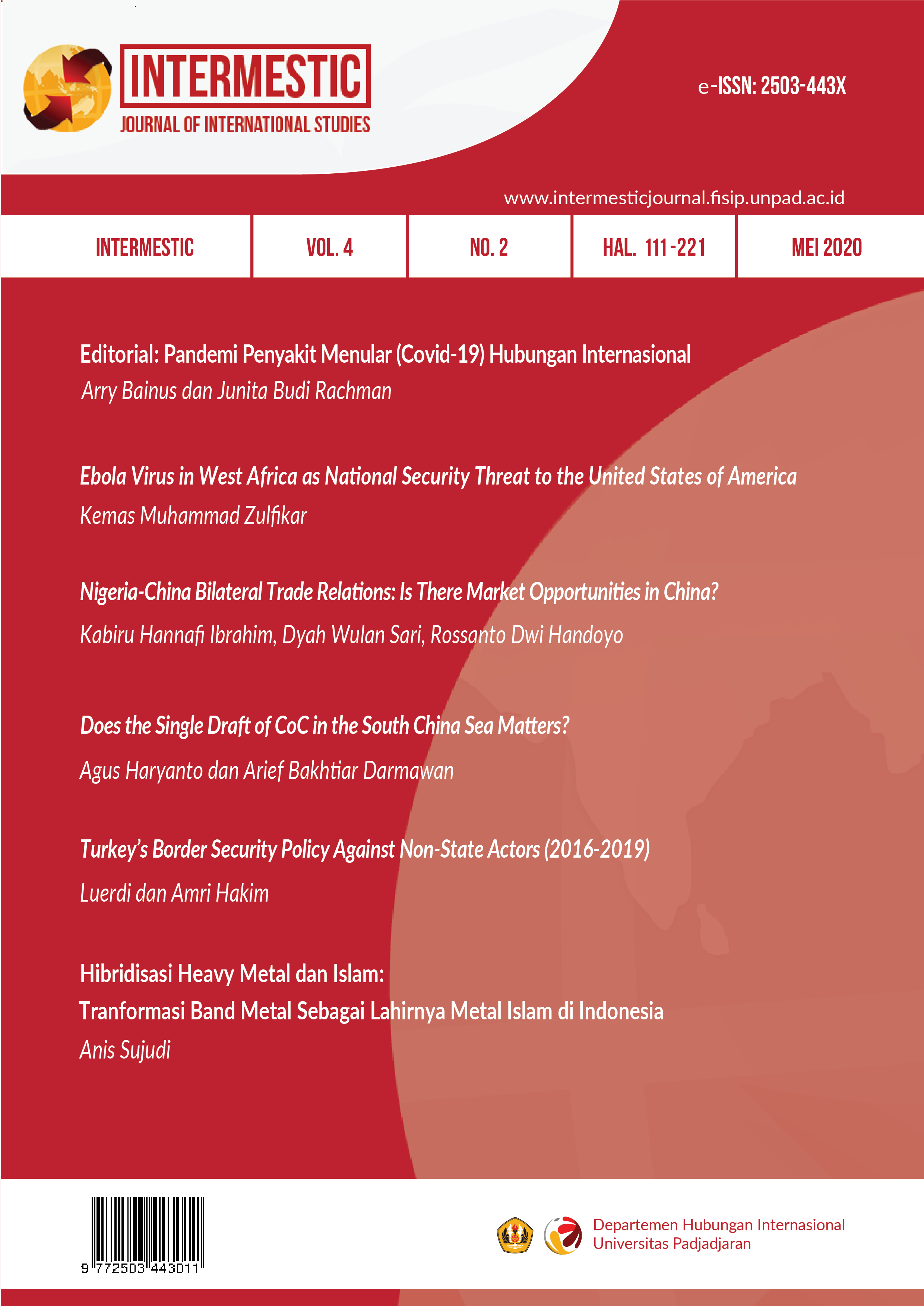Nigeria-China Bilateral Trade Relations: Is There Market Opportunities in China?
Main Article Content
Abstract
This study used normalized revealed sectoral comparative advantage, import demand share, growth identification and facilitation framework to identify market opportunities for Nigeria in the Chinese markets over the period 1988-2017. Our findings revealed that Nigeria has a steady and long-term comparative advantage in few commodities and there is limited scope for Nigeria to improve on its balance of trade due to limited export potentials. Furthermore, sixteen market opportunities were identified, out of which fourteen are stable and growing markets. Our findings also revealed that these market opportunities can't all be meet by Nigeria, as these commodities were not exportable due to poor competitive position and highly capital-intensive nature of the commodities. These findings are not only relevant to academics but also for policy making.
Article Details
Issue
Section

This work is licensed under a Creative Commons Attribution-NonCommercial-ShareAlike 4.0 International License.
The authors submitting a manuscript do so on the understanding that if accepted for publication copyright of the article shall be assigned to Intermestic: Journal of International Studies, International Relations Department, Padjadjaran University as the publisher of the journal.
References
Alao, A. (2011). Nigeria and the BRICs: Diplomatic, Trade, Cultural and Military Relations (O c c a s i o n a l P a p e r No. 1 0 1).
Amavilah, V. H. S. (2003). “‘Does Trade Cause Growth?’ - A Comment,.”
Ayodele, T. & Sotolo, O. (2014). China in Africa: An Evaluation of Chinese Investment (IPPA Working Paper Series (2014)).
Ayoola, T. J. (2013). Nigeria-China Trade Relations: Implication on the Nigerian Domestic Economy. Research Journal of Finance and Accounting, 4(17), 98–104.
Balassa, B. (1965). Trade Liberalisation and “Revealed” Comparative Advantage. The Manchester School of Economics and Social Studies, 33(2), 99–123. https://doi.org/10.1111/j.1467-9957.1965.tb00050.x DOI: https://doi.org/10.1111/j.1467-9957.1965.tb00050.x
Benedictis, L. De. (2005). Three Decades of Italian Comparative Advantages. The World Economy, 28(11), 1679–1709. DOI: https://doi.org/10.1111/j.1467-9701.2005.00752.x
Ekesiobi, C., Ifebi, O., Ibekilo, B., & Onochie, J. (2011). Dynamics of Foreign Trade and Trade Relation Problems: Policy Options for Nigeria. African Research Review, 5(1), 40–56. https://doi.org/10.4314/afrrev.v5i1.64508 DOI: https://doi.org/10.4314/afrrev.v5i1.64508
Eneji, et. al. (2012). Impact of foreign trade and investment on Nigeria’s textile industry:
The case of China. Journal of African Studies and Development, 4(5), 130–141. https://doi.org/10.5897/jasd12.004 DOI: https://doi.org/10.5897/JASD12.004
Hammerstad, A. (2011). Nigeria and the Global Powers: Continuity and Change in Policy and Perceptions (O c c a s i o n a l P a p e r N o. 9 6; Issue 96).
Ibrahim, K. H. (2015). Trade Complementarity and Similarity between Nigeria and India in the context of Bilateral Trade Relations. IOSR Journal of Economics and Finance, 6(6), 28–32. https://doi.org/10.9790/5933-06642832
Ibrahim K. H. & Sayuti, A. S. (2017a). Nigeria’s Export Supply versus Brazil’s Import Demand: 2000-2016. Ife Social Sciences Review , 5(1), 48–58.
Ibrahim K. H. & Sayuti, A. S. (2017b). Nigeria’s Trade Complementarity and Similarity with West African Sub-Region. Benue Journal of Social Sciences, 5(1), 122–138. DOI: https://doi.org/10.2139/ssrn.3189001
Ibrahim, K. H. & Abdulaziz, S. (2016). Nigeria-India Bilateral Trade Relations: An Analysis of Trade Complementarity Index (TCI). Asian Journal of Economic Modelling, 4(4), 190–198. DOI: https://doi.org/10.18488/journal.8/2016.4.4/8.4.190.198
Ibrahim, K. H. & Iorember, P. T. (2018). Sectoral and Products wise Comparative Advantage in Nigerian-China Bilateral Trade Relations. Dutse Journal of Economics and Development Studies (DUJEDS), 6(1), 110–117.
Ibrahim, K. H. & Sari, D. W. (2019a). An Examination of Recent Trends Composition and Trade Intensity of Nigeria-BrazilBilateral Relations. International Journal of Advanced Economics, 1(1), 31–43. DOI: https://doi.org/10.51594/ijae.v1i1.28
Ibrahim, K. H. & Sari, D. W. (2019b). Nigeria-China: An Examination of Recent Bilateral Trade Relations. International Journal of Applied Research in Social Sciences, 1(5),172–184. DOI: https://doi.org/10.51594/ijarss.v1i5.29
Ibrahim, K. H. & Yusuf, M. M. (2017). Diversification of the Nigerian Economy: Prospects and Emerging Issues in the External Sector Export. In A. M. Fagge, B. G.
Gumel, & B. A. Ahmed (Eds.), Readings in Economics 2 (DIVERSIFICATION OF THE NIGERIAN ECONOMY) (pp. 284–307). Ahmadu Bello University Press Limited, Zaria, Kaduna State, Nigeria.
Ibrahim, K. H. & Singh, D. (2014). Changing Perspective of Indo-Nigerian Trade Relations. Indian Journal of Applied Research, 4(7), 497–503. https://doi.org/10.15373/2249555x/july2014/157 DOI: https://doi.org/10.15373/2249555X/July2014/157
Lin, J. Y. & Monga, C. (2011). Growth Identification and Facilitation: The Role of the State in the Dynamics of Structural Change (Policy Research Working Paper No.5313).
Nabine, D.-W. (2009). The impact of Chinese Investment and and Trade on Nigeria economic growth (ATPC Work in Progress;No.77).
Ogunkola, E. O., Bankole, A. S. & Adewuyi, A. (2008). China ‐Nigeria Economic Relations, AERC Scoping Studies on China-Africa Economic Relations.
Pant, M., & Pande, D. (2014). India-Pakistan Trade: An Analysis of the Pharmaceutical Sector (Working Paper 275).
Sen, S. (2012). International Trade Theory and Policy: A Review of the Literature. SSRN Electronic Journal, 635. https://doi.org/10.2139/ssrn.1713843 DOI: https://doi.org/10.2139/ssrn.1713843

